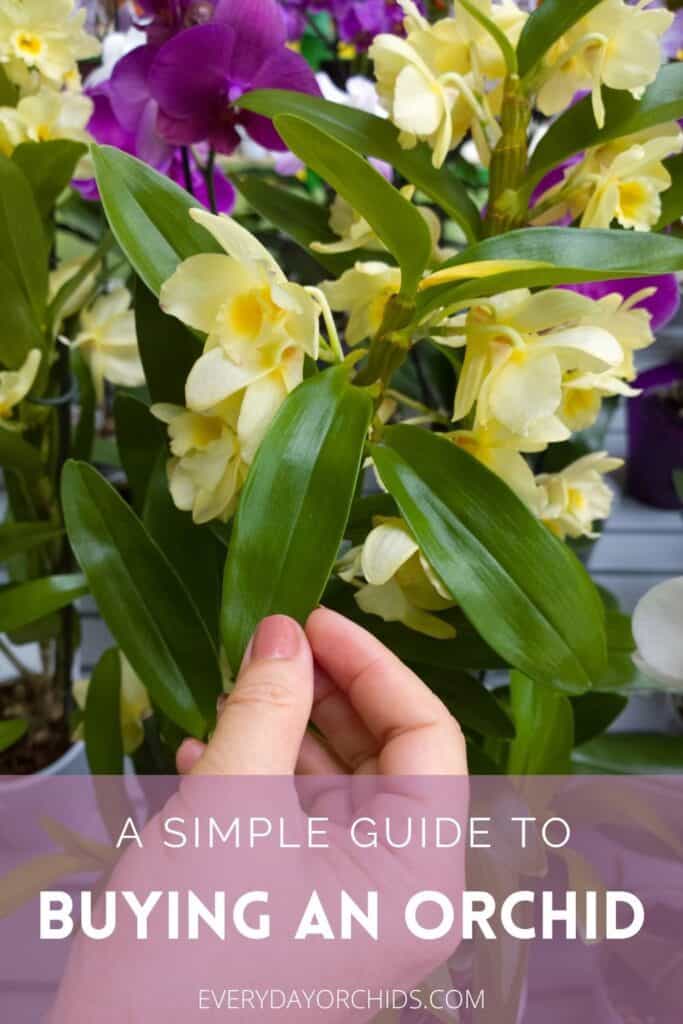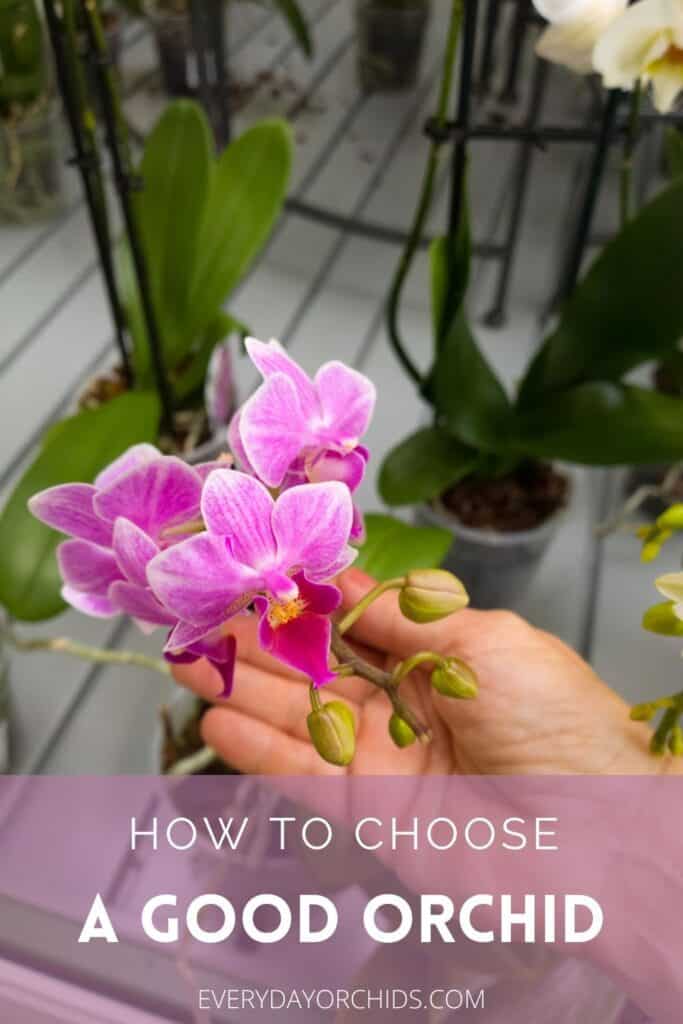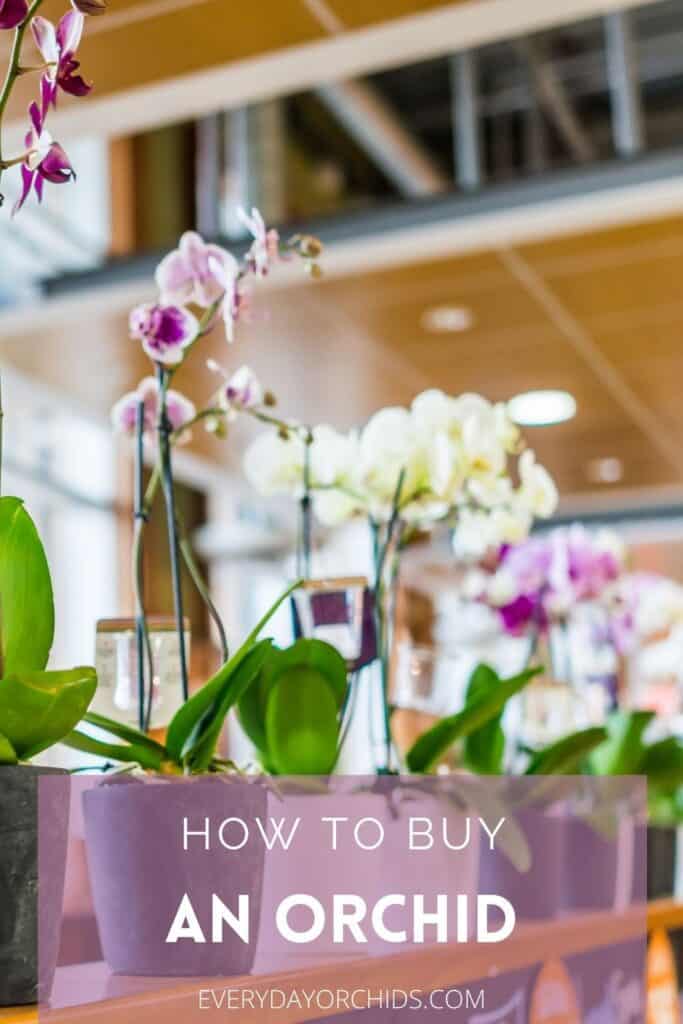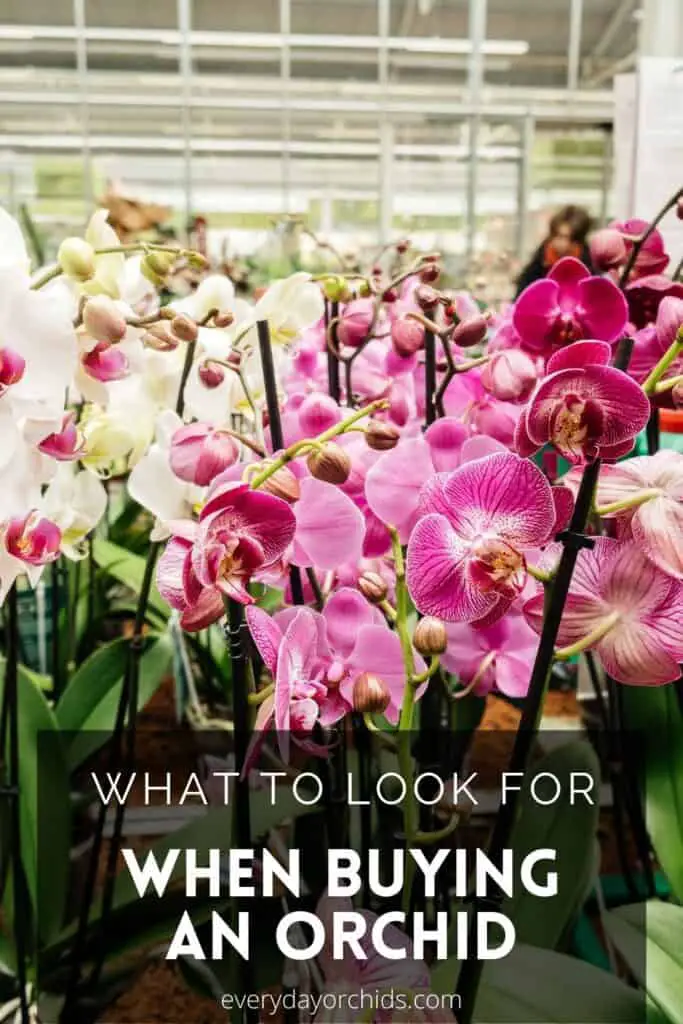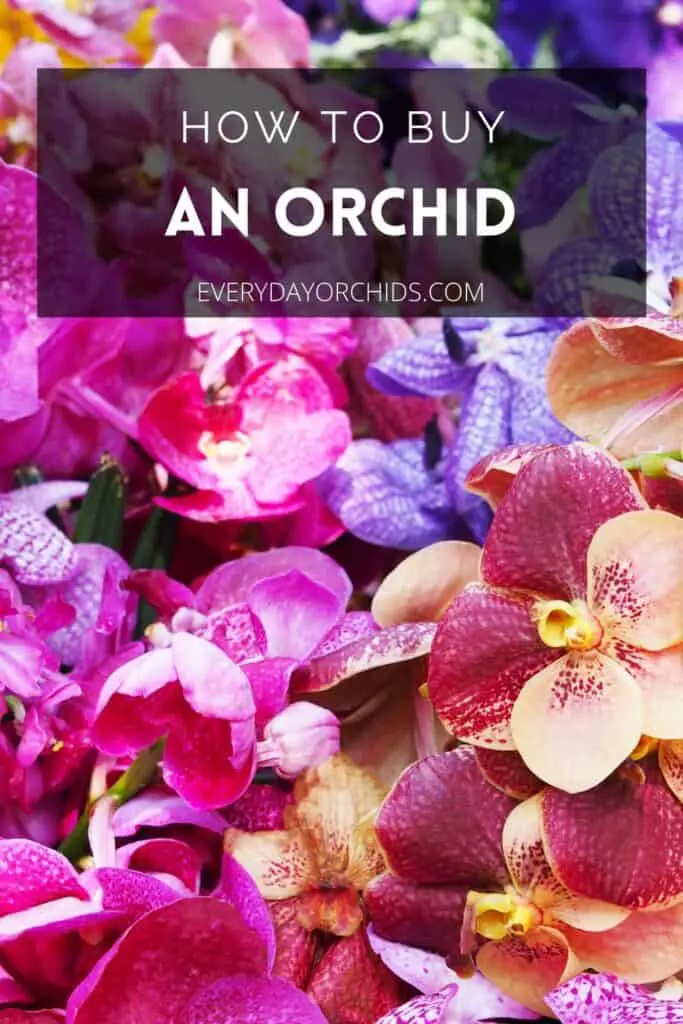When buying an orchid, many people first look at the blooms: how many flowers there are and what they look like. While there is nothing wrong with this, it’s not all you want to be checking out when choosing a new orchid.
When buying a new orchid, thoroughly inspect the leaves, roots, and flower stems. Check the potting media and it’s condition. Look for signs of pests or disease. Doing a full inspection before you leave the store will increase your chances you bring home a healthy, quality orchid.
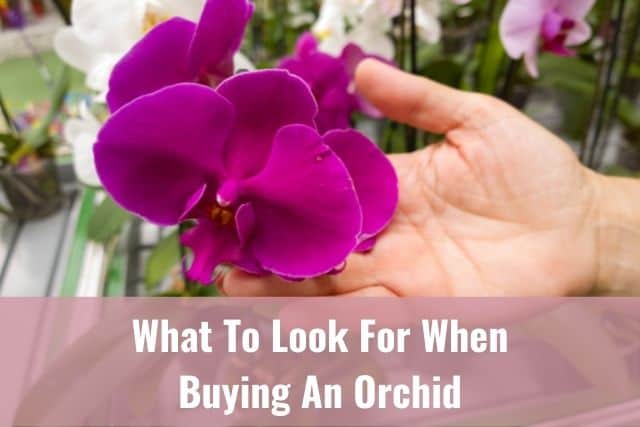
Whether or not you are new to orchids, this helpful guide will walk you through how to inspect an orchid. A careful and thorough inspection is absolutely necessary whenever buying a new orchid. This will help ensure that you will be going home with not only a beautiful new orchid, but a healthy one too. Below, I’ll go over each part of the orchid and what you should expect to find if the orchid is in good condition.
Please note that these links are affiliate links and as an Amazon Associate, I earn from qualifying purchases. Purchases made through affiliate links in this post may generate commissions at no additional cost to you. Use this link for a discounted Amazon Prime trial. Thank you for your support!
Table of Contents
What Healthy Orchid Leaves Should Look Like When Buying An Orchid

First and foremost, check the orchid’s leaves. The color, shape, texture and overall appearance of orchid leaves can tell you a lot about the health of the orchid.
Healthy orchid leaves should be a bright, grassy green color.
Phalaenopsis orchid, Dendrobium and Epidendrum leaves should be firm, wrinkle-free, and evenly green, with no discolored tips or edges. Thin-leaved orchids, such as Oncidium and Miltoniopsis orchids, should have green leaves cascading naturally around the plant.
If the orchid leaves are a different color, such as yellow, brown or red, that could be an indication of nutrient deficiency, excessive sunlight exposure, disease, or some other problem. Steer clear of this orchid if that is the case.
Likewise, avoid an orchid that has a number of split, broken or cracked leaves. One or two split leaves might be fine. After all, if this is the only problem with the orchid and it is otherwise healthy, split leaves are more of a cosmetic issue than anything else. However, if the majority of the leaves are cracked or split, it tells you that the orchid was not well-cared for or protected in transit.
Give the leaves a gentle tug.
The orchid leaves should remain firmly attached to the orchid. Leaves should not come off easily with a gentle tug. If they do, put the orchid back, as this is a sign that the orchid may have crown rot or is sick or diseased.
Check the underside of the orchid leaves.
Many times, orchid pests will hide under the leaves. If you look under the orchid leaves, you should see a firm, smooth, evenly green surface. There should not be any white bits of fuzz, pock marks, or webbing. If you do, these are all signs of a pest infestation.
Unless you are prepared to deal with a pest infestation immediately after purchasing the orchid, I would advise you to put it back.
Even if you feel up to a challenge, keep in mind that an orchid plagued with pests or disease is likely going to be stressed and weakened as well. It will be more susceptible to further pests and disease. It may or may not survive much longer after you bring it home, depending on the severity of the infestation or infection.
Dealing with a pest infestation or a diseased orchid is be a lot of work. There is also the risk that bringing home an infested or diseased orchid may spread the pests or disease to the rest of your household plants.
What if the orchid leaves are twisted, curled or deformed looking?
At times, orchid leaves may appear twisted or curled. The leaves may have vertical or horizontal splits as well. Most of the time, this is not a deal breaker. As long as the orchid leaves look otherwise healthy and the rest of the orchid passes inspection, the orchid is safe to buy.
What Healthy Orchid Roots Should Look Like

Different orchid species have different types of orchid roots. Here is a broad overview of what healthy orchid roots should look like.
Phalaenopsis Orchid Roots
Phalaenopsis orchids are the most commonly sold (and purchased) orchids out there. I’ll start with these roots. Healthy Phalaenopsis orchid roots should be plump, firm, and silvery-white when dry and green when wet.
Look at the aerial roots first. They may be a number of silvery-gray orchid roots extending up and around the orchid plant. This is perfectly normal. These roots should be plump and firm.
Dry, shriveled, or brown aerial roots can indicate a lack of watering or humidity. While it is something to take note of, this is not a deal breaker if you can see that the under-ground roots are healthy.
Check the under-ground roots.
If the orchid is potted in a clear, plastic orchid pot, you will be able to check the rest of the roots easily.
A healthy, growing orchid should have plenty of silvery-white or green roots.
The roots may be tightly packed into the plastic container, which is fine for now. Orchids tend to like to be pot-bound. You may just need to repot your orchid as soon as the blooming period is done. Some roots may have green tips as well, which is a positive sign the roots are growing.
What you don’t want to see is a lot of brown, mushy looking roots or wrinkled, shriveled orchid roots. This is an obvious indication that the orchid has not been well-cared for. It has been either over-watered or under-watered.
A few dead or rotted roots are fine. You can always prune these off later when you repot your orchid. What you don’t want to see is a large number of dead roots.
While it is possible to save an orchid without roots, the truth is, it takes work and time. It’s probably not something you want to take on right after bringing your new orchid home.
Among other things, you will need to repot the orchid and in doing so, risk losing the orchid flowers. If you are a new orchid grower or looking to give this orchid as a gift, I would discourage you from buying any orchid with mushy and brown or dried and shriveled orchid roots.
Oncidiums, Dendrobiums And Other Thin-Rooted Orchids
Many sympodial orchids, including Oncidiums, Dendrobiums, Epidendriums and Miltoniopsis orchids, have thin orchid roots. These roots are very delicate and resemble thin tendrils.
Healthy orchid roots will be white, silvery-white, or green, depending on if they are dry or wet. You should see an abundance of these roots in the potting media and peeking out of the top of the pot.
If you have a cane-orchid such as a Dendrobium or Epidendrum, you may also see keiki orchids and their roots growing from various nodes along the cane. These keikis will have white roots with green tips. These roots will extend out from the node and sit on the other side of the keiki.
If you see keikis on the orchid, that is generally a great sign. Usually keikis will grow like this on an orchid that is healthy and thriving. What’s more, keikis are easy and natural ways to propagate orchids. Before long, your one orchid will turn in to multiple orchids.
A few dried orchid roots, especially if they are aerial roots, is not a deal breaker. However, if a number of roots are brown, dried or black with rot, stay away and do not buy.
When Buying An Orchid, Check The Flower Spikes And Orchid Stem

What should you see when you first look at the orchid’s flower spikes and stem? Here are some key things you should find if the orchid is healthy and in good condition.
Orchid Stem
First, inspect the main orchid stem. This is not the flower spike or inflorescence, but the main stem with leaves attached to it. It should be firm, green and healthy. The stem should have a number of green leaves extending out from it.
A healthy orchid stem should not be discolored, spotted, or mushy. If it is, it could have rot or disease. In many cases, a rotted, diseased orchid stem means that the orchid won’t have long to live. Do not buy.
Orchid Crown
If you thinking of buying a Phalaenopsis orchid, take a look at the crown of the orchid stem. This is the center area where the top two leaves meet and slope down and in.
If this center area, called the crown, is healthy, you will not see anything of note. You may just see a new leaf growing, which is a good sign.
You do not want to see any darkened or blackened areas in the center of the crown. Standing water in the crown, even if it is just a small amount, isn’t good either. Seeing this could indicate the beginnings of crown rot.
Unfortunately, crown rot can kill orchids quickly. It is due to standing water left in the crown of the plant. If it is not caught early on and treated immediately, crown rot is very hard to get rid of. It can quickly kill the orchid. Avoid buying an orchid with any suspicious discoloration or damage to its crown.
Sympodial orchids, such as Oncidiums, will not have an obvious crown. Instead, you will want to inspect the pseudobulbs. I’ll talk about that more below.
Flower Spikes, Buds and Blooms
Next, check the flower spikes, which as also called inflorescences. Most likely, these orchid blooms were what attracted you to this orchid in the first place.
Ideally, the orchid will have more than one flower stem with both open orchid blooms and closed flower buds.
Buds
Flower buds should be firmly intact on the spike, not wrinkled, shriveled, or dry looking. They should not be yellow or faded-looking. If they are, this indicates bud blast. Those buds will never open up or bloom. They will soon fall off the flower spike.
If the orchid is experiencing bud blast, it is also likely that the existing open blooms will fall off early. This happens when the orchid is exposed to less than ideal conditions.
Blooms
Make sure that the orchid blooms do not have any unusual spotting or markings on the petals or sepals. If you see spotting or marking on some of the blooms, but not all, be wary. Viruses, fungi and other pathogens can cause an orchid’s blooms to have discoloration or spotting. If you see this on the orchid, put it back. There is a chance it is infected with a disease.
In addition, if you choose an orchid that no longer has any buds and the orchid is fully in bloom, be aware that the orchid may not be in bloom much longer. It’s possible that those older blooms have already been open for weeks. They may fall off a couple weeks after you bring the orchid home. You may not get to enjoy the orchid blooms for as long as you thought you would.
Ideally, you want an orchid with multiple flower spikes and a mix of open blooms and flower buds.
Inspect The Orchid’s Pseudobulbs
If you are buying a sympodial orchid such as an Oncidium or Cattleya orchid, you will notice that the orchid has bulb-shaped structures nestled amongst the leaves. These are pseudobulbs and function as a water and nutrient storage organ for the orchid.
For the most part, healthy orchid pseudobulbs will be firm, smooth, green and wrinkle-free. The exception to this rule is if the pseudobulb is older. Older pseudobulbs may have wrinkles, but should still be firm and green.
If you notice dark discoloration anywhere on the pseudobulb, that could be a sign of rot. Deep wrinkles across all the pseudobulbs is a sign of under-watering.
Limp, yellowed, pseudobulbs are also a sign of under-watering. Chances are, this orchid’s roots are also likely dry and shriveled. No matter how much you like the orchid blooms, this orchid is not a good buy.
When Buying An Orchid, Look For Orchid Pests
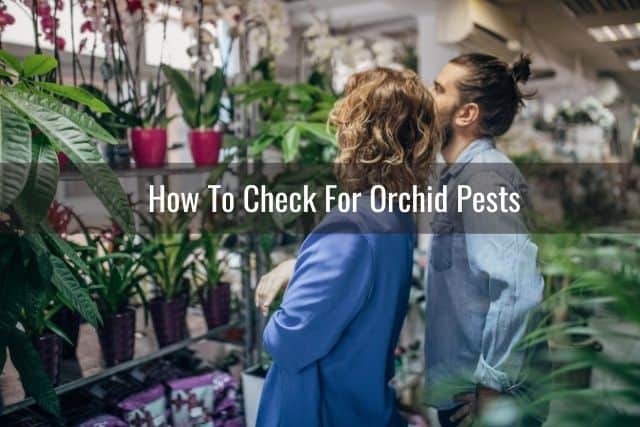
Though this is one of the last things I will cover, it is by no means the least important. If anything, checking for orchid pests is one of the key things you should do before you buy an orchid.
Check the leaves and undersides of the leaves for pests.
A serious orchid spider mite infestation can be manifested by a silvery white color under the leaf. A fine layer of webbing along the entire underside of the leaf makes it look silvery white…until you touch it and realize its a web. There may be pock marks or pin-sized dots along the leaf as well. You may also see webbing between the branches of the flower spike and roots.
Check all the nooks and crannies where pests like to hide.
Mealybugs love to hide in the crevices of orchids as well as under the leaves. These may be mistaken for white fluff or fuzz. Look in the orchid’s crown, the joints between the orchid stem and leaves, the branches of flower spikes, in the flowers, and buds. These are all places they like to hide.
Mealybugs are actually fairly easy to get rid of, but if I am buying a new orchid, I wouldn’t want to start with one infested with anything, no matter how simple the treatment is. Its just too risky that there may be other, hidden problems that you may not be aware of until you get home.
Check the potting media for pests.
Fungus gnats are small black flies, similar to fruit flies. If you see little black flies around the orchid when you pick up the pot, pay attention and check the potting media.
These little flies like to hide in the potting media. Fungus gnats are a sign of overly moist potting media and can be notoriously hard to get rid of. Oftentimes, fungus gnats are a sign of overwatering. In many cases, the orchid likely has root rot as well. Steer clear of this orchid.
These are just a few of the orchid pests that can attack orchids. For more information, read this guide on how to spot orchid pests and get rid of them.
Be aware that there are a number of orchid pests that can stay well hidden in an orchid’s leaves and pot.
In fact, you may not notice that your orchid has pests until days after you bring it home.
Many times, pest problems may not be apparent in the store. An orchid can pass your inspection with flying colors, only to have you later realize that it had hidden spider mites or some other orchid pest a week later.
Therefore, one of the first things you will need to do with any new orchid is to give it a quarantine period. To learn more, read this guide on what to do with a new orchid.
When Buying An Orchid, Look For Signs of Rot Or Disease
The most obvious signs of rot are brown, darkened mushy areas. Rot can be found in the roots, pseudobulbs, or orchid crown.
Disease can most easily be seen in the orchid leaves. It may appear as brown spots on the leaves or black dots or discoloration on the leaves.
You may also notice mushy, soft, or oozing patches on the leaves or roots. There may be light brown or yellow-colored rings on the leaves. Flowers may be spotted or have discolored petals. These are all signs of various bacterial, viral, or fungal diseases that can affect orchids.
If you suspect the orchid is diseased in any way, definitely put it back and do not buy it. Most likely, it hasn’t passed the leaf, root or flower inspection either.
Nursing a diseased orchid back to health is a lot of work. There is also the chance that by bringing an infected plant home, you are risking the health of your other houseplants.
Final Thoughts
By now, you can see why buying an orchid is more involved than just looking at the blooms and picking the best looking flowers.
Orchids can live for decades if they are healthy and cared for properly. If you are wanting an orchid to add beauty to your home or office for years to come, carefully inspect the entire orchid, from the leaves and flower stems down to the roots.
Use this guide to help you determine whether or not the orchid you see in the store is a healthy plant and the right one for you. As always, happy orchid growing!
If you enjoyed this article, please pin it and share!
